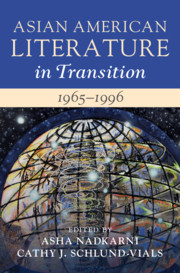Book contents
- Asian American Literature in Transition, 1965–1996
- Asian American Literature In Transition
- Asian American Literature in Transition, 1965–1996
- Copyright page
- Contents
- Contributors
- Series Preface
- Introduction
- Part I Immigration, Migration, and Movement
- Part II Politics, Art, and Activism
- Part III Institutionalization and Canon Formation
- Part IV Diaspora and the Transnational Turn
- Chapter 15 Rethinking Nationalistic Attachments through Narratives of Return
- Chapter 16 Diasporic Longings
- Chapter 17 Transnational Sexualities
- Chapter 18 Intimacy, Imperialism, and America: Revisiting Post-47 Postcolonial and Asian American Writing
- Chapter 19 Hemispheric Imaginings and Global Transitions: The Geopolitics of Asian American Literature in the Americas
- References
- Index
Chapter 19 - Hemispheric Imaginings and Global Transitions: The Geopolitics of Asian American Literature in the Americas
from Part IV - Diaspora and the Transnational Turn
Published online by Cambridge University Press: 08 June 2021
- Asian American Literature in Transition, 1965–1996
- Asian American Literature In Transition
- Asian American Literature in Transition, 1965–1996
- Copyright page
- Contents
- Contributors
- Series Preface
- Introduction
- Part I Immigration, Migration, and Movement
- Part II Politics, Art, and Activism
- Part III Institutionalization and Canon Formation
- Part IV Diaspora and the Transnational Turn
- Chapter 15 Rethinking Nationalistic Attachments through Narratives of Return
- Chapter 16 Diasporic Longings
- Chapter 17 Transnational Sexualities
- Chapter 18 Intimacy, Imperialism, and America: Revisiting Post-47 Postcolonial and Asian American Writing
- Chapter 19 Hemispheric Imaginings and Global Transitions: The Geopolitics of Asian American Literature in the Americas
- References
- Index
Summary
This chapter considers the hemisphere as a geopolitical heuristic for Asian American literature. While the era of 1965 to 1996 is considered pivotal for new growth in Asian American populations in the United States because of liberal reforms in immigration policy, it was also one in which the expansion of the global Cold War led US power to brutally target newly decolonized and revolutionary societies in its fight against Communism. This chapter examines how diasporic Asian literatures from the period illuminate the mechanisms of “development” from the Cold War to the neoliberal, postsocialist present. Beyond registering the presence of Asians in the Americas since the sixteenth century, the chapter argues that various “hemispheric imaginings” grapple with the disavowed operations of political violence by which Latin American and Asian nations were “transitioned” from a region of nonaligned, postcolonial republics to capitalist states ruled by comprador and transnational elites. At the same time, a hemispheric imaginary provides a method for reading artists’ visions of alternate, shared futures and South–South, transracial solidarities that continue to haunt the postcolonial world.
Keywords
- Type
- Chapter
- Information
- Asian American Literature in Transition, 1965–1996 , pp. 345 - 362Publisher: Cambridge University PressPrint publication year: 2021

